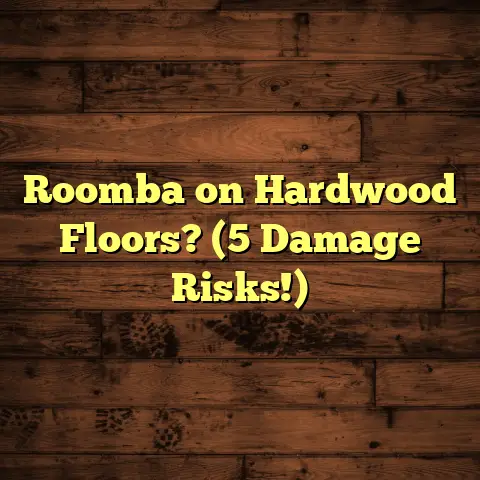Concrete Paving Slab Types (2 Critical Differences!)
2 Critical Differences for Optimal Selection
I’m Mark, a flooring contractor with over 15 years of experience.I’ve seen it all when it comes to concrete paving slabs, from driveways that crumble under pressure to patios that become skating rinks in the rain.
Trust me, choosing the right concrete paving slab is more than just picking a pretty color.
It’s about understanding the nuts and bolts of what makes a slab durable, safe, and perfect for your specific project.
That’s why I’m here to break down the two critical differences between concrete paving slab types: texture and strength.
Understanding these aspects will help you make an informed decision, ensuring your outdoor spaces look great and last for years to come.
Section 1: Overview of Concrete Paving Slabs
What are Concrete Paving Slabs?
Concrete paving slabs are pre-cast concrete elements used to create hard surfaces. Think driveways, patios, walkways, and even pool decks.
They offer a durable and aesthetically pleasing alternative to poured concrete or other paving materials like asphalt or natural stone.
I’ve used them in countless projects, and I can tell you, they’re a versatile and cost-effective solution for many outdoor applications.
A Little History Lesson
Did you know that the use of concrete for paving dates back to ancient Rome?
The Romans were masters of concrete construction, and their paved roads are a testament to the material’s durability.
However, modern concrete paving slabs as we know them today began to gain popularity in the early 20th century.
Over the years, advancements in concrete technology have led to improvements in strength, durability, and aesthetics.
We now have a wide range of colors, textures, and sizes to choose from, making concrete paving slabs a stylish and practical choice for any project.
Why the Right Slab Matters
Choosing the right type of concrete paving slab is crucial for the success of any outdoor project.
A slab that’s too weak for the intended use will crack and crumble under pressure.
A slab with the wrong texture can become slippery when wet, posing a safety hazard.
I’ve seen homeowners make costly mistakes by choosing slabs based solely on appearance, only to regret it later.
That’s why understanding the two critical differences—texture and strength—is so important.
Section 2: The Two Critical Differences in
Concrete Paving Slabs
2.1 Texture of Concrete Paving Slabs
What is Texture?
Texture refers to the surface finish of the concrete paving slab. It’s not just about aesthetics; it plays a crucial role in safety and maintenance.
A smooth slab might look sleek and modern, but it can be treacherous when wet.
A textured slab, on the other hand, provides better grip and can enhance the overall look of your outdoor space.
Types of Textures
Let’s dive into some common texture types:
- Smooth: As the name suggests, these slabs have a smooth, even surface. They are often used for indoor applications or covered patios where slip resistance is less of a concern.
- Brushed: Brushed concrete has a slightly rough surface created by dragging a brush across the wet concrete. This texture provides good slip resistance and is a popular choice for walkways and patios.
- Stamped: Stamped concrete mimics the look of natural stone, brick, or other materials. It’s created by pressing molds into the wet concrete. Stamped concrete can be textured to provide slip resistance.
- Exposed Aggregate: This texture reveals the aggregate (small stones) within the concrete mix. It’s created by removing the surface layer of cement paste. Exposed aggregate provides excellent slip resistance and a unique aesthetic.
- Textured Molds: These slabs are cast in molds that impart a specific texture to the surface. The textures can range from subtle patterns to more pronounced designs.
Aesthetic Implications
The texture of your concrete paving slabs can significantly impact the overall look and feel of your outdoor space.
Smooth slabs create a modern, minimalist aesthetic. Brushed slabs offer a more traditional, understated look.
Stamped concrete can add a touch of elegance and sophistication.
Exposed aggregate provides a rustic, natural feel.
When choosing a texture, consider the style of your home and the overall design of your outdoor space.
Practical Implications: Safety and Maintenance
Texture plays a crucial role in safety, especially in areas that are prone to getting wet.
Slip resistance is measured by a coefficient of friction (COF).
A higher COF indicates better slip resistance.
According to the Americans with Disabilities Act (ADA), accessible walkways should have a COF of 0.6 or higher.
You can find more information on ADA standards here.
When it comes to maintenance, smooth slabs are easier to clean than textured slabs.
However, textured slabs are better at hiding dirt and stains.
I often advise homeowners to seal their concrete paving slabs, regardless of the texture.
Sealing helps protect the concrete from water damage, stains, and UV degradation.
2.2 Strength of Concrete Paving Slabs
Understanding Concrete Strength
The strength of concrete is measured in pounds per square inch (PSI).
This rating indicates the amount of compressive force the concrete can withstand before it cracks or fails.
For example, a concrete slab with a PSI rating of 4,000 can withstand 4,000 pounds of pressure per square inch.
Factors Affecting Strength
The strength of concrete depends on several factors, including:
- Mix Design: The ratio of cement, water, aggregate, and admixtures in the concrete mix. A well-designed mix will produce stronger concrete.
- Curing Process: Curing is the process of keeping the concrete moist for several days after it’s poured. This allows the cement to fully hydrate, resulting in stronger concrete.
- Reinforcement: Adding steel reinforcement (rebar or wire mesh) to the concrete increases its tensile strength and load-bearing capacity.
Strength Comparison
Concrete paving slabs are available in a range of strengths.
Here’s a general guideline:
- Unreinforced Slabs: These slabs typically have a PSI rating of 3,000 to 4,000. They are suitable for walkways and patios with light foot traffic.
- Reinforced Slabs: Reinforced slabs have a PSI rating of 4,000 to 5,000 or higher. They are designed for driveways and other areas that will be subjected to heavy loads.
Load-Bearing Capacities
The load-bearing capacity of a concrete paving slab is the maximum weight it can support without cracking or failing.
This is a critical consideration when choosing slabs for driveways.
According to the Portland Cement Association (PCA), a typical residential driveway should be able to support a load of at least 4,000 pounds per axle.
You can find more information on driveway design here.
Strength and Longevity
The strength of your concrete paving slabs directly impacts their longevity and durability.
Stronger slabs are better able to withstand the stresses of freeze-thaw cycles, heavy traffic, and other environmental factors.
In areas with harsh winters, I always recommend using reinforced concrete slabs with a high PSI rating.
This will help prevent cracking and spalling, ensuring your outdoor spaces look great for years to come.
Section 3: Practical Applications and Case Studies
Let’s look at some real-world examples to see how texture and strength come into play:
Case Study 1: Residential Driveway
- Project: A homeowner wanted to replace their old asphalt driveway with concrete paving slabs.
- Requirements: The driveway needed to withstand the weight of two cars and occasional delivery trucks.
- Solution: I recommended reinforced concrete slabs with a PSI rating of 4,500. The slabs were textured with a brushed finish to provide slip resistance.
- Outcome: The driveway has held up beautifully for over five years with no signs of cracking or deterioration. The brushed texture provides excellent grip, even in wet weather.
Case Study 2: Commercial Walkway
- Project: A business owner wanted to create an inviting walkway leading to their storefront.
- Requirements: The walkway needed to be accessible to people of all abilities and able to withstand heavy foot traffic.
- Solution: I recommended smooth, high-strength concrete slabs with a PSI rating of 5,000. The slabs were sealed with a non-slip coating to meet ADA requirements.
- Outcome: The walkway is both aesthetically pleasing and safe for pedestrians. The smooth surface is easy to clean and maintain, and the non-slip coating provides excellent traction.
Lessons Learned
These case studies highlight the importance of choosing the right type of concrete paving slab for your specific project.
Consider the intended use of the space, the amount of traffic it will receive, and the environmental conditions.
Don’t be afraid to consult with a professional contractor to get expert advice.
Section 4: Conclusion
Recap of Critical Differences
Texture and strength are the two critical differences between concrete paving slab types.
Texture affects safety, aesthetics, and maintenance. Strength impacts load-bearing capacity and longevity.
Importance of Considering These Factors
When selecting paving slabs for any project, it’s essential to consider both texture and strength.
Choose a texture that provides adequate slip resistance and complements the overall design of your outdoor space.
Select a strength that can withstand the intended use of the space and the environmental conditions.
Evaluate Your Specific Needs
Before you start shopping for concrete paving slabs, take the time to evaluate your specific needs.
Ask yourself:
- What is the intended use of the space?
- How much traffic will it receive?
- What are the environmental conditions?
- What is my budget?
Answering these questions will help you narrow down your options and make the best choice for your concrete paving solutions.
I hope this article has given you a better understanding of concrete paving slab types.
Remember, choosing the right slab is an investment in the longevity and beauty of your outdoor spaces. Good luck with your project!





